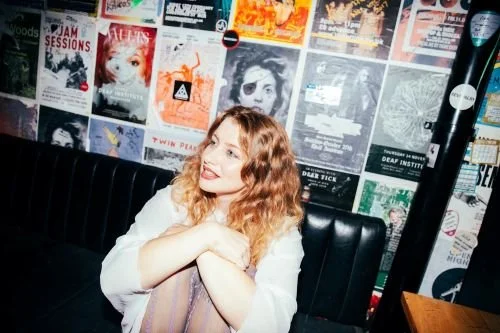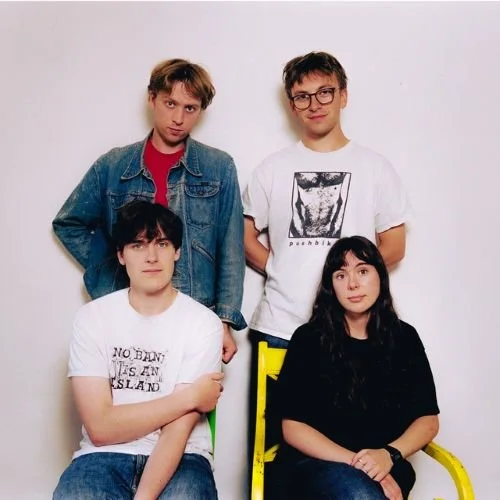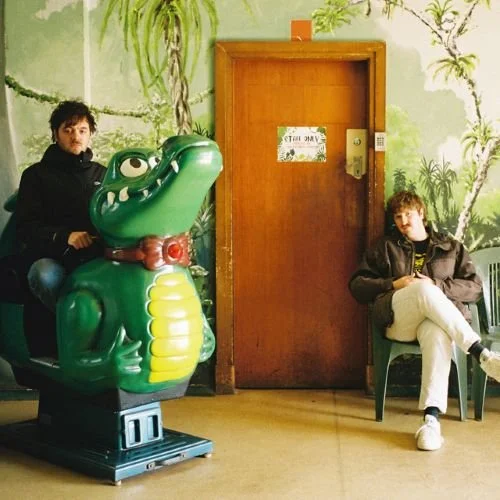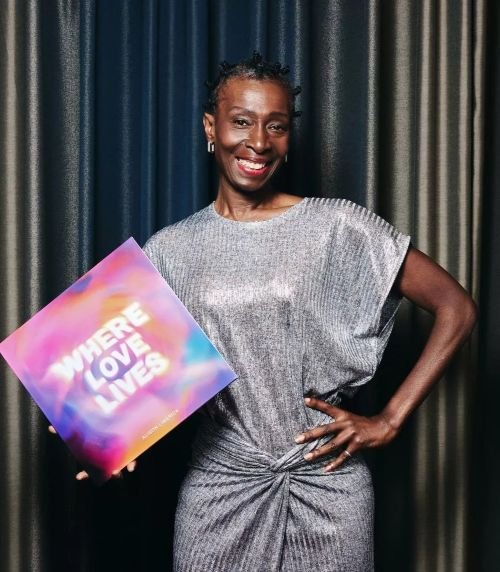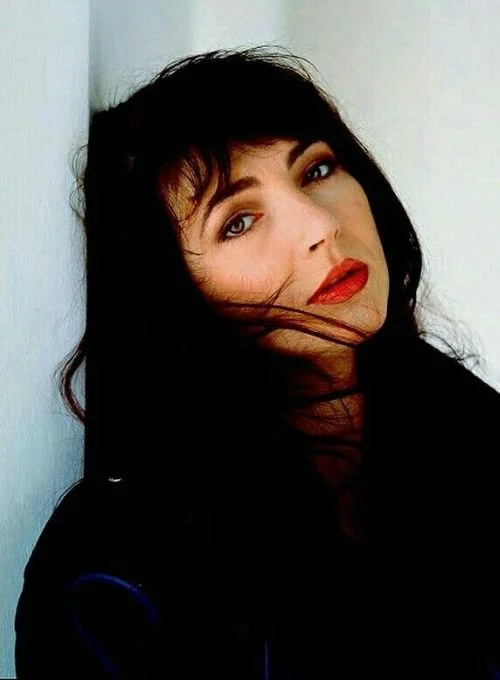FEATURE:
Celebrating an Underrated Christmas Classic
Kate Bush’s December Will Be Magic Again at Forty-Five
__________
EVEN though there was no music video…
IN THIS PHOTO: Kate Bush in a promotional photo for her 1979 Christmas Special, Kate/PHOTO CREDIT: TV Times
for this track, I think that December Will Be Magic Again is one of Kate Bush’s best singles. One of the best Christmas tracks. It was originally recorded in 1979 and premiered during the Christmas Snowtime Special, which was broadcast on 22nd December, 1979 in the U.K., though it was not officially released until 17th November 1980. Its B-side is the brilliant Warm and Soothing. That song was the first thing she ever recorded at Abbey Road Studios. December Will Be Magic Again was issued as the follow-up to Army Dreamers (from 1980’s Never for Ever). Quite a shift in terms of themes, many were not expecting a Christmas single from Kate Bush after something like Army Dreamers! However, this is not her only Christmas song. Home for Christmas was released in 1992. It originally appeared in the BBC television The Comic Strip Presents film, Wild Turkey, screened on 24th December, 1992. It was then included as the B-side on the U.K. release of Moments of Pleasure (a single from 1993’s The Red Shoes). However, December Will Be Magic Again is the superior track. Marking forty-five years of a classic, I want to get to some December Will Be Magic Again background. I am going to repeat some details I put into previous features, as I write about this song every year. As she (sadly) had become used to at this point, Bush was subjected to sexism and criticism from some of the ‘cooler’ music papers. Those who felt she was too twee or a novelty. This is some of the criticism that December Will Be Magic Again received:
“Looks like we’ll have to endure that fairy Kate Bush… over the cash-register season… Kate is “cute”… and no doubt you’ll be force fed, as you will with turkey.
Andy Gill, NME, 29 November 1980
Sounding like she’s just been rutted from the rear with a particularly rampant reindeer, Kate reminds us of the joys of the season at considerable length and expense. Lush, sentimental, extravagantly produced… destined to become a Christmas irritation; and airwave itch you won’t be able to scratch.
Allan Jones, Melody Maker, 6 December 1980”.
It must have been upsetting for Bush to see such words printed! However, whilst these press idiots are wrong and didn’t recognise a great Christmas song when they heard it, luckily, fans have embraced it! Played around this time each year, you do hear it on stations like BBC Radio 2. It is one of those songs I always gravitate towards. Even if there are some conventional and traditional Christmas images, Kate Bush laces in images that are distinctly from her: “Light the candle-lights/To conjure Mr. Wilde/Into the Silent Night/Ooh, it’s quiet inside/Here in Oscar’s mind”. Reaching number twenty-nine in the U.K., I think that December Will Be Magic Again should be reissued as a single. It would do well today. With a fairly simple and effective composition, it is a magical song that stays in the heart. The chorus is quite dizzying: “Like the snow/Come to cover the lovers/(Cover the lovers,/But don’t you wake them up)/Come to sparkle the dark up/(Sparkle the dark up/With just a touch of make-up)/Come to cover the muck up/(Cover the muck up/Ooh, with a little luck)/December will be magic again”. I think my favourite live version of the song was for the Christmas Special, Kate, which was broadcast on 28th December, 1979, and features Bush on piano and Kevin McAlea on keyboards and electric piano. In 2020, Abbey Road Studios celebrated forty years of the single. That is the studio where the song was recorded. They shared the recording times and when the final mix happened. A great artefact! Tune Tempest heralded a Christmas classic for this amazing feature:
“December Will Be Magic Again” was released as a standalone single in November 1980, during a pivotal period in Kate Bush’s career. Having already solidified her reputation as a visionary artist with three successful studio albums (The Kick Inside, Lionheart, and Never for Ever), Bush was exploring new creative directions. The song arrived as a festive offering to her growing fanbase, showcasing her ability to weave seasonal charm into her distinctive sound.
While the track wasn’t tied to a specific album, it reflected her flair for theatrical storytelling and vivid imagery. Its origins were likely influenced by Bush’s deep appreciation for nostalgia and fantasy, themes that permeate much of her work. The lyrics reference classic holiday traditions and figures like Bing Crosby, suggesting an homage to the golden age of Christmas music. Bush’s jazzy, playful arrangement nods to the genre’s rich history while remaining unmistakably her own.
Musical Composition
“December Will Be Magic Again” showcases Kate Bush’s signature knack for blending unconventional musical elements into a cohesive and enchanting sound. The song’s instrumentation is lush and dynamic, opening with a twinkling piano melody that evokes the warmth and wonder of the holiday season. Layered with orchestral flourishes, jazzy rhythms, and playful percussion, the arrangement feels both whimsical and sophisticated, capturing the festive spirit in a way that’s uniquely Kate Bush.
Bush’s ethereal vocals are the centerpiece, effortlessly shifting between soft, intimate tones and soaring, exuberant heights. Her voice dances around the melody with an almost childlike sense of joy, yet retains the depth and artistry that define her music. Notably, the song incorporates an unconventional rhythm, with a swing-like quality that gives it a lively, jazzy feel—setting it apart from the solemn ballads or cheerful jingles typical of Christmas music.
Key features that make the song stand out include the vivid use of dynamics and Bush’s intricate vocal phrasing, which imbue the track with an air of theatricality. The production captures a sense of wonder, as if inviting listeners to step into a holiday dreamscape, making it a standout among seasonal offerings.
Cultural Impact
Upon its release in November 1980, “December Will Be Magic Again” was met with a warm, albeit modest, reception. While it did not achieve the commercial heights of other holiday staples, the song was appreciated by fans and critics for its originality and Kate Bush’s unmistakable artistry. Its whimsical charm stood apart from the predictable fare of Christmas music, making it a cult favorite among her loyal following.
The song was notably performed during Bush’s appearance on the 1979 BBC television special, Kate, where she delivered an enchanting rendition that highlighted her theatrical flair. In this performance, Bush’s expressive movements and ethereal stage presence brought the festive imagery of the song to life, solidifying it as a visual and auditory holiday treat. This version is often remembered as one of the definitive interpretations of the track.
Why It’s Unique Among Christmas Songs
“December Will Be Magic Again” stands out among Christmas songs for its ability to capture the holiday spirit without relying on the standard tropes of the genre. While many festive tracks lean heavily on predictable jingles, choral refrains, and overt cheer, Kate Bush takes a more nuanced and artistic approach, blending her signature ethereal style with an imaginative celebration of the season.
The song’s tone is whimsical and dreamlike rather than overtly celebratory. Bush paints vivid, poetic images—snowflakes falling, reindeer riding across her room—that evoke a sense of wonder and magic unique to her perspective. Her jazzy arrangement and unconventional rhythms diverge from the traditional march of sleigh bells and carols, offering a fresh sonic palette that feels more like an intimate, theatrical performance than a festive sing-along.
Rather than focusing solely on overt joy, Bush’s lyrics embrace the reflective and nostalgic aspects of the season. References to Bing Crosby and the golden age of Christmas music ground the song in tradition, but she reimagines these elements through her singular lens, avoiding cliché. Her use of metaphors, such as falling snow symbolizing beauty and transience, adds a layer of depth that transforms the song into an evocative piece of storytelling”.
There are articles like this that tell the story of December Will Be Magic Again. Also, Dreams of Orgonon wrote about this Christmas gem in 2019. Even if they feel it does not have too much meat on the bones, it was Kate Bush’s first Christmas track, and one that I feel is worthy of a lot more praise and investigation:
“Bush doesn’t completely break from this pattern, as “December” is straightforwardly nostalgic. From the longing for the past implied by its title to its dwelling on childhood images, the song spends it runtime on a reconstruction of Christmas childhood memories. Bush settles into the falsetto end of her vocal range, singing lots of high notes with a wonder usually only prepubescents can manage. Bush has exactly the sort of voice which makes lyrics like “take a husky to the ice/while Bing Crosby sings “White Christmas”/he makes you feel nice” sound cutely intuitive in a way we’re not prone to seeing in things like “Wonderful Christmastime.”
Yet for its exercise in nostalgia, it separates itself from the mainstream of Christmas music by being a little too eccentric to be quite marketable (the song did pretty well in the charts, but was far from one of Bush’s bestselling singles). Bush’s own East Wickham childhood makes its way into the song. She has a refreshing tendency to lean on her own interests in her songwriting, which liberates “December” from feeling too commercial. There are the obvious references to staples of Christmastime like “old Saint Nicholas) (who is grossly maligned by the entire UK as “Father Christmas”) and romantic traditions (“kiss under mistletoe”), but they’re balanced by images of Oscar Wilde showing up: “light the candle lights/to conjure Mr. Wilde/ooh, it’s quiet inside/here in Oscar’s mind.”
The song expresses this in an offbeat way in how it splits the focus between Christmassy bits and more generic moments about December’s atmosphere and snow “com[ing] to cover the dark up,” but it’s still just a reasonably fun Christmas song. Bush seems to think more of it, however, as she recorded a number of different versions of the song. “December” made its debut in, of course, a 1979 BBC program embarrassingly called The Christmas Snowtime Special, featuring performances from ABBA, Boney M, and Bonnie Tyler. This version of the song proves counterintuitive, as in addition to its standard Christmas bells it has drummer Preston Heyman playing bongos. It’s a conga-inflected recording like “Room for the Life,” which is… not what you’d expect a song boasting lyrics about Bing Crosby and Oscar Wilde. Even stranger is the song’s accompanying video, with an obviously stoned Bush wearing red pajamas whirling around in a red armchair and relishing whatever strain Santa has brought for her. By far the most extravagant video of the song, it’s an underrated classic of Bush’s videography that should be taught in every film studies class.
The next TV performance of the song appeared in the “Kate” special, and is by far its more minimalist production. There’s a simple setup of Bush at the piano with Kevin McAlea playing keyboards behind her, while Preston Heyman rings small bells during the chorus. Stripped of its artifice, “December” is a pleasantly quiet little tune, placing Bush’s vocals and melody at its center. Admittedly this was the “December Will Be Magic Again” I knew before writing this blog post, and its unobtrusiveness makes it the preferable recording for me. Bush’s strengths often lie in maximalism (wait until we get to “Breathing” or “Waking the Witch”), but working as an acoustic artist lets her shine as a singer-pianist as well.
Finally there’s the single version of the song that made it to #29 in the UK (it fared better in Ireland, a consistent supporter of Bush, where it reached #13) and it gets the final say on how this song gets read. Released two months after Never for Ever, it’s a standalone single that clearly wants to fill the “Wuthering Heights” and “Wow” archetype. Never for Ever is decidedly less a pop record than its predecessors, and pointedly lacks a sweeping dramatic single about the power of youthful precocity. Releasing a nostalgic paean like “December Will Be Magic Again” in its wake is an odd move, one that feels like Bush is pushing against the current trajectory of her songwriting in order to revive a song that debuted before “Babooshka.” That’s understandable — serious artists get to do silly holiday anthems as well. The problem with the single recording of “December Will Be Magic Again” is that it’s convinced the song merits the same seriousness as “Wuthering Heights” and “Wow.” It’s overproduced to hell, sounding more like a Phil Collins track than a Christmas ballad with its slow, powerful drumming, soaring guitar solos, and agonizingly overstated backing vocals from Bush. It’s hard to figure out why Bush recorded this song so many times — perhaps her perfectionism took over for a while. Whatever the case, it’s much easier to imagine this song working as a quiet piano-driven B-side for, say, “Army Dreamers,” which already had “Passing Through Air” for backmatter. The single is mistimed, needing to be set back a year or so for it to work.
Yet with “December Will Be Magic Again,” we see the end of a certain kind of Bush song. It’s her last track that can be feasibly reimagined as hailing from her pre-Kick Inside years, with its relish for childhood delights and simple attributes of a domestic environment. That approach has reached a breaking point. From now on her quiet songs will be more adult and introspective. She’s going to do silly songs in the future, of course — but even the silly stuff often carries plenty of weight. Bush’s earlier work is an ambitious testament to what youthful artistry can accomplish. Few songwriters are particularly mature early in their career. With Bush, a lot of her recurring themes from across her career are already in place on her first couple albums. For all its shortcomings, “December Will Be Magic Again” signals the end of Bush as prodigy as she moves into the era of the Fairlight, global conflict, and becoming a masterful singer to rival Peter Gabriel. Farewell, last of the Phoenix tradition. You’ve carried us far.
Recorded at London AIR Studios in 1979. Performed on 22 December for BBC Snowtime Special and 28 December for “Kate” special. Single version recorded in November 1980. Released as a single on 17 November 1980”.
Turning forty-five on 17th November, the beautiful and underrated December Will Be Magic Again is a jewel that I love hearing every year. It is not really Christmas until we hear this song! I have highlighted some negative reviews. In 1990, Stuart Maconie declared December Will Be Magic Again as "one of the neatest Christmas tunes since Spector" in his This Woman's Work box-set review. Ronnie Gurr of Smash Hits described it thus: "novel with her optimistic December operetta”. So not everyone was trashing it! On its forty-fifth anniversary, I hope that this majestic song gets the…
LOVE it deserves.









